Day 4: What’s ahead for Coco, Yogi and Bern?
30 March 2015
As the Ben Tre rescue team contemplate their final days on the road, thoughts are turning to what’s next for bears Coco, Yogi and Bern.
Their days of bile extractions are over and their cages left thousands of kilometres behind – but a decade of pain and suffering isn’t remedied overnight. The rehabilitation of a bear is a long and very individual process.
When the bears arrive at the sanctuary, they will first need to be quarantined for 45 days. It’s a vital step to protect the health of all the bears at the sanctuary, but also requires careful management to keep the bears stimulated.
During this time there’ll be plenty of extra treats, as well as puzzle feeders and even new tastes and smells specially designed to stimulate the bears and fend off boredom.
Animals Asia’s Vietnam Bear and Vet Team Director Annemarie Weegenaar said:
“When the vet team believes they are ready, the bears will receive full health checks and any medical procedures they require. This might include the removal of their gall bladder if significantly damaged by bile extraction. For poor Yogi it will mean removing damaged teeth and ensuring he approaches his new life pain free.
“We’ll get to show these bears all the love and care they have been missing in their lives to date. They’ll need all their strength to continue their rehabilitation and adjust to the changes coming their way.”
As Bern was not anaesthetised during his rescue, the team know little about the state of his health. An ultrasound scan should show if he has any history of bile extraction.
Following quarantine Coco, Yogi and Bern can expect to be moved to a much larger indoor area – either dens or a double bear house.
The reaction of each bear to this new, large environment will very much depend on their personality and past experiences. Some rescued bears initially find the move to a larger space traumatic and can be reluctant to enter at first, while others relish having more space to play and jump right in.
Once each bear is comfortable in the den, the next step is usually careful integration with other bears. Moon bears are not thought to be social animals in the wild, and so communities must be carefully managed.
Prior to integration, sanctuary staff carefully monitor the bears for signs of stress or aggression. If there are no negative signs then the bears will be introduced in a non-threatening environment under careful management.
The most significant step in any bear’s rehabilitation is their first steps out into an enclosure. Whether this takes place before or after integration with other bears, it is a milestone in any bear’s recovery and – like the introduction to a den – each bear reacts differently.
Over time, Coco, Yogi and Bern will realise that this new good life is for ever and they’ll start to relax. They will learn to live with other bears, to trust their human carers – to forage and play and finally live the life denied them by the bear bile industry.
BACK









 Freedom after two decades: Moon bears Nang and Mua rescued
Freedom after two decades: Moon bears Nang and Mua rescued
 With heavy hearts we say goodbye to our beloved Tulip
With heavy hearts we say goodbye to our beloved Tulip
 Three moon bears rescued from notorious bear bile farming hotspots in Vietnam
Three moon bears rescued from notorious bear bile farming hotspots in Vietnam
